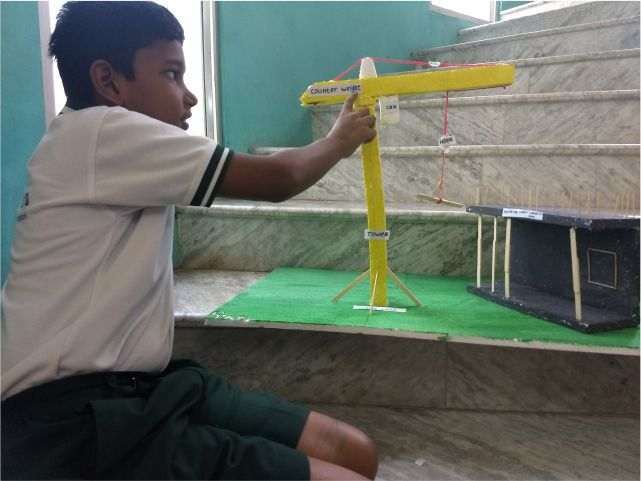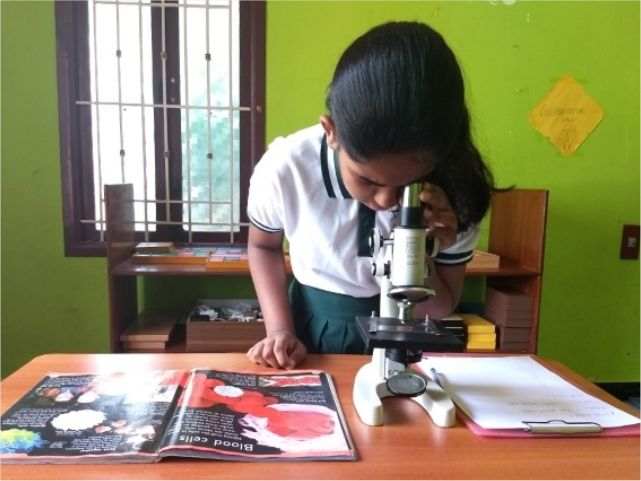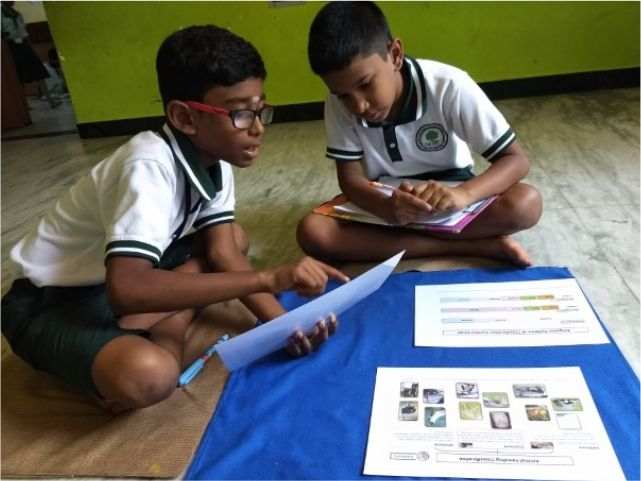Transdiciplinary Science
Montessori Elementary Science Curriculum
Elementary Science
In the Vruksha – International School of Montessori Elementary program, science is about the world, not mere words to be memorized. We enable children to understand and appreciate the natural world, and the crucial role of science and technology in enabling humans to flourish. In contrast to other programs, which often rely on textbooks to transmit disconnected scientific terms and formulae, in our Montessori Elementary program, science starts with children observing the natural world, then classifying, describing, and sketching their observations. Often, student’s studies retrace the historical logic of scientific discovery. In the process, students come to appreciate the wondrous world we live in. They gain a profound understanding of, and respect for, the life-sustaining role of scientific discoveries and technology in their lives.

Our science program has three main goals:
To make careful, curious observers of the world out of our students. Our focus is on helping students to make observations across a wide range of scientific topics, and to let them explore these as much as possible while following their own interests. We want our students to be intensely curious about the world, and to show them how to translate that intense curiosity into careful, deliberate observations.
To develop a foundation of scientific observations and vocabulary, upon which later systematic and more theoretical science study can build. Science, at Vruksha, is always about the world, not about disconnected scientific jargon. Our students first learn to observe, and then to think about their observations. We don’t bombard them with advanced theories to memorize; instead, we carefully select observations and simplified explanations that are accessible to them at their developmental level. Interestingly, by learning science (and history and geography) this way, children also improve their reading skills: much of reading in Upper Elementary and beyond rests on children having relevant background knowledge. Our rich science and cultural curriculum puts our students at an advantage, compared to the narrower curriculum common in the early elementary years at schools where literacy and math standardized testing looms large.
To develop a fundamental conviction that science can help us understand and live in this world. We want our students to internalize the view that the world out there is a fascinating, relevant topic worthy of their interest and attention. Because we build upon our student’s innate curiosity about the world, and because we enable them to explore topics that interest them, the answers they discover are personally meaningful. From the beginning, science is a tool for them to satisfy their desire to understand the world. It is practical and useful; it is interesting and rewarding; and it is a subject they enjoy and are eager to pursue.
The Method
Focus on the World, not Words – Observation First, Explanation Second

Our science program raises interesting questions, and then guides the students as they observe, classify, and draw conclusions. Throughout, students actively apply what they learn: they work with classification cards; they conduct experiments; they observe demonstrations, answer questions, and summarize their observations. Our science program is always about understanding the world, not about scientific jargon, which is why we do not ask students to study lessons from traditional textbooks, and memorize theories by rote.
Instead, our students might:
In Lower Elementary, use animal classification cards to make real to themselves why different vertebrae are grouped into different classes. They study fish, amphibians, reptiles, birds, and mammals.
Conduct simple experiments in physical science. They may observe that air takes up volume by placing a funnel tightly into a bottle, and watching what happens when they pour water into it, or by trying to blow up a balloon in a bottle. Sometimes, teachers demonstrate these lessons; other times, children experiment on their own, reading instructions from science experiment cards, setting up experiments, and recording their observations in a science journal.
Explore independently with Mystery Science. In addition to small group lessons and independent research, in Upper Elementary, we take advantage of Mystery Science, an online program that allows children to pursue topics of high interest independently, as self-initiated units either alone or in small groups. Each online lesson is presented as a mystery for children to investigate and consists of an exploration component (video and discussion points) and an activity component (step-by-step instructions for a hands-on activity.)
Observe large-scale, long time physical developments, such as the formation of rivers, erosion, and sedimentation by means of simplified physical models. The teacher may create a v-shaped “river model” with clay, colored sand, and pebbles, and by pouring water, show them how rivers form, how they carry soft earth downstream, how pebbles get swept away, and how sediment layers form in river deltas.
Go outside and observe nature. They may find constellations in the night sky, observe birds and ants in the school yard, or collect plant specimen on field trips.
“At Vruksha, they make learning so fun that even a 3rd grader notices the difference. My younger daughter will be entering 3rd grade. She recently told me: ‘At our old school, we couldn’t do anything. All we did was look at books, then take tests. Now, we get to do all kinds of fun things, look at birds, go outside, look at plants and trees. It’s totally different here at Vruksha!’ If a 3rd grader is noticing, and mentioning it to me, without me even asking—that shows you what a different attitude towards learning there is at Vruksha.”
- A ParentThe Content
A Broad Base of Observational Knowledge across Life Science, Earth Science, & Physical Science

Our Montessori Elementary science program ranges broadly across life science,
physical science, and Earth science. We ensure our students are exposed to some content from each.
Within each area, we provide them the opportunity to delve deeper depending on their own interests.
Our goal is to train our students to observe carefully, discover interesting questions, and use
their observations and research to answer them. The goal at this age is not to cover each area
exhaustively, or even to ensure each student acquires a specific body of knowledge in each. Rather,
we want to introduce students to the interesting questions and puzzles of science, by means of some
representative, selective content.
We thus give our students plenty of choice regarding
what to explore, and how deeply they want to follow their interests. Each classroom may cover
different areas of science from year to year.
The following list gives an indication of the kinds of topics our students study:
Life Sciences: Our life sciences curriculum consists largely of botany and zoology. Children are naturally interested in plants and animals, and eagerly embrace the process of observing and classifying them. Learning more about plants and animals especially those they encounter in their lives outside of school ensures that science satisfies their curiosity about the world “out there”, and thus is meaningful to them. In each area, we begin our study with systematic observations, and guide our students to be attentive, to classify their observations, and to draw conclusions from what they see. For example, when students study classification, they aren’t content to merely memorize terms or written statements of definitions. Instead, we ask our students to apply what they learn. For example, a teacher might share photos from a select groups of plants or animals, ask students to place them in the appropriate family, and then explain their placement. These exercises are fun for our students–and by applying what they learn, they remember, and become attuned to nature. The students enjoy this work so much that many of them will even bring to class photographs they take in their free time of animals or plants, or will relate experiences of the organisms they identify in their backyard, on vacation, etc.
Botany: We ensure our students understand the basic structure of plants, the function of the key parts, and the differences between plants and animals. We introduce our students to different types of plants, and help them observe and classify the plants they encounter in their surroundings.
Zoology: Our students study the different classes of animals, and gain an applied understanding of the traits characterizing different animals (e.g., how they move, what they use for protection, what they eat and how they digest it). Our goal is for students to be able to look at the bodily systems of an animal, classify the animal, and draw conclusions about its nature from this classification. Once they are grounded in these basic observational facts, we encourage students to research a more advanced topic that interests them. For example, a student may investigate the life cycles of animals, or how animals in the same class may differ based on where they live (e.g., desert vs. prairie vs. forest).
Earth and Physical Sciences: Our focus here is to introduce our students to a broad range of interesting observations, and to help them develop basic skills, such as measuring, observing, and recording observations.
Sun and the Earth: We introduce our students to the special relationship of the sun to our planet. For example, they learn that it is connected to the seasons, solstices and equinoxes, temperature zones, and so on. Through this work, our students gain an understanding of lines of latitude and longitude, and time zones. By Upper Elementary, we may introduce additional celestial observations—such as moon phases, constellations, and the path of the observable planets through the night sky.
Geology and functional geography: To help students understand the world around them, we study the work of water (e.g., erosion, the formation of rivers, and sedimentation) and the work of air (e.g., that it rises when heated, insulates, and circulates in a pattern). Throughout, we highlight the observations that are accessible to them given their knowledge, emphasizing both vocabulary development and careful observation. For example, in geology we start out by handling all kinds of rocks, and classifying them by their characteristics. We handle limestone, sandstone and clay, and carefully observe their properties. (How hard are they? What are their colours? What happens when we apply acid to them?) We contrast these rocks with granite and basalt, guiding our students as they discover the classes to which these rocks belong (sedimentary and igneous). We take our students on field trips, where they can see the rocks in their natural environments. And ultimately, we build upon these and other observations as we help them understand how geologists have developed the theories that explain the key geological phenomena we can experience around us–such as volcanoes, earthquakes, and mountains.Go outside and observe nature. They may find constellations in the night sky, observe birds and ants in the school yard, or collect plant specimen on field trips.
Simple machines/introduction to mechanics: In the Upper Elementary program we study the earliest machines used by human beings, and see how applied technology, even at its most basic level, made human life better. We may experiment with inclined planes, levers, wheels and axles, and pulleys experiments that help students understand their world better. They can see these items in action around them, and are motivated to explore their operations further.
Get in Touch with Us
Our Headquarters are in Chennai and Puducherry
27-28, 2nd Cross
Moogambigai Nagar
Reddiarpalayam, Pondy - 605 010
Phone: +91 9994851951
Phone: +91 9361919996
Email: contact@vrukshamontessori.com
24-25, 12th Cross
Ranga Reddy Gardens
Neelankarai, Chennai - 600 041
Phone: +91 9994851951
Phone: +91 9361919996
Email: contact@vrukshamontessori.com
